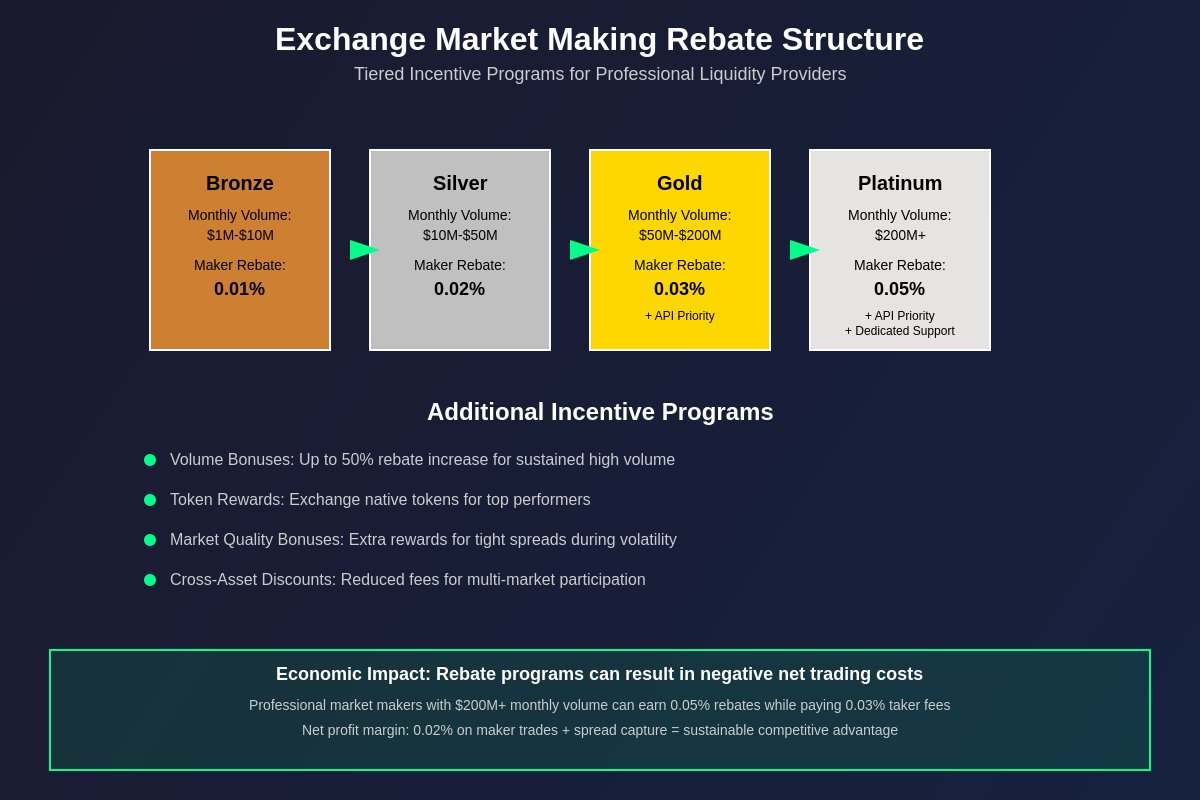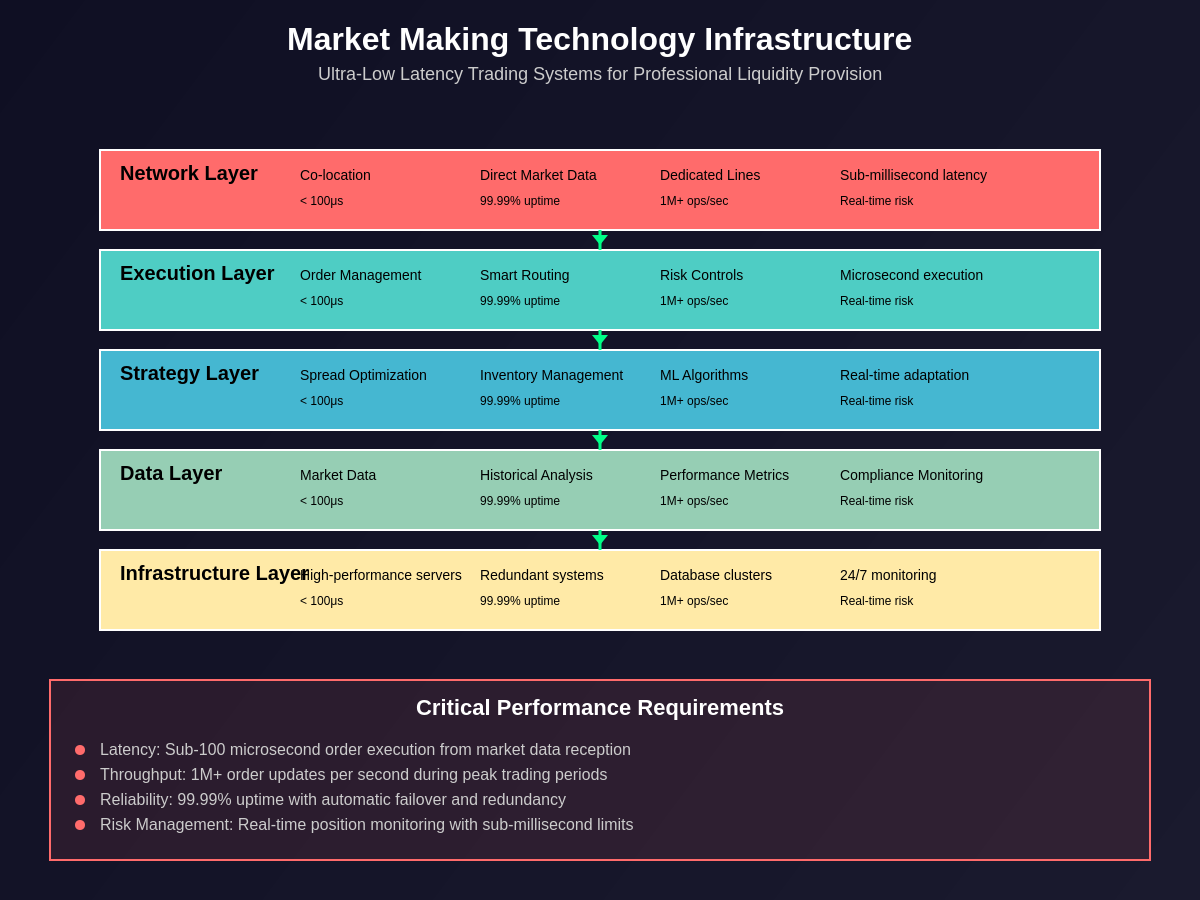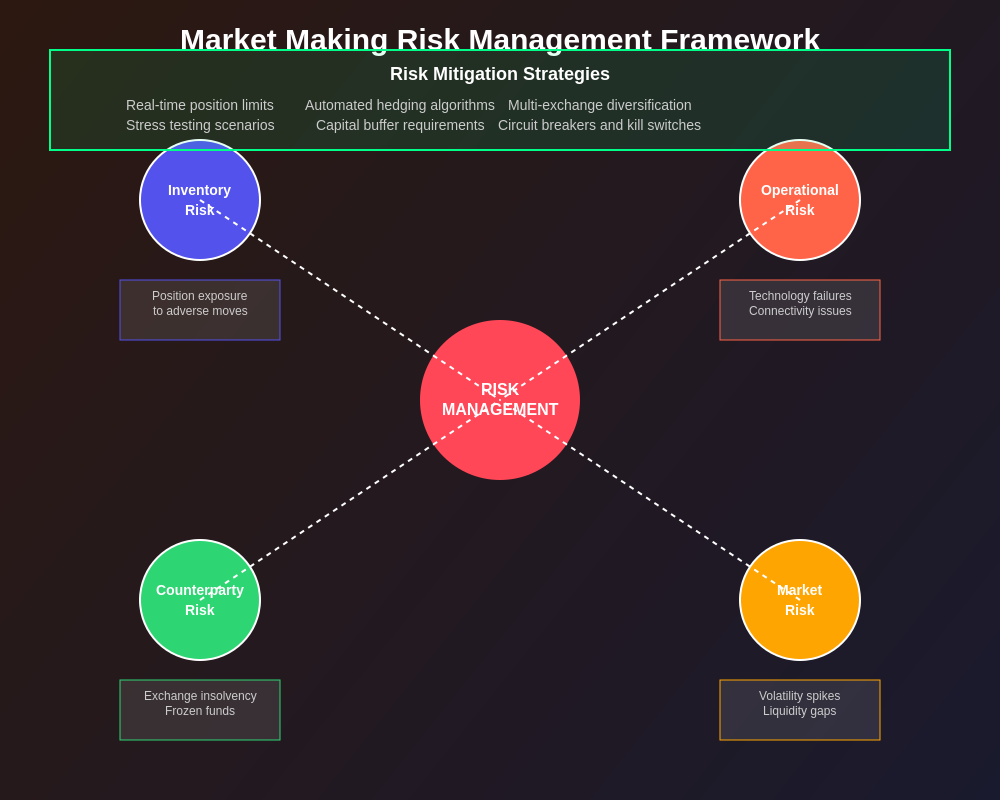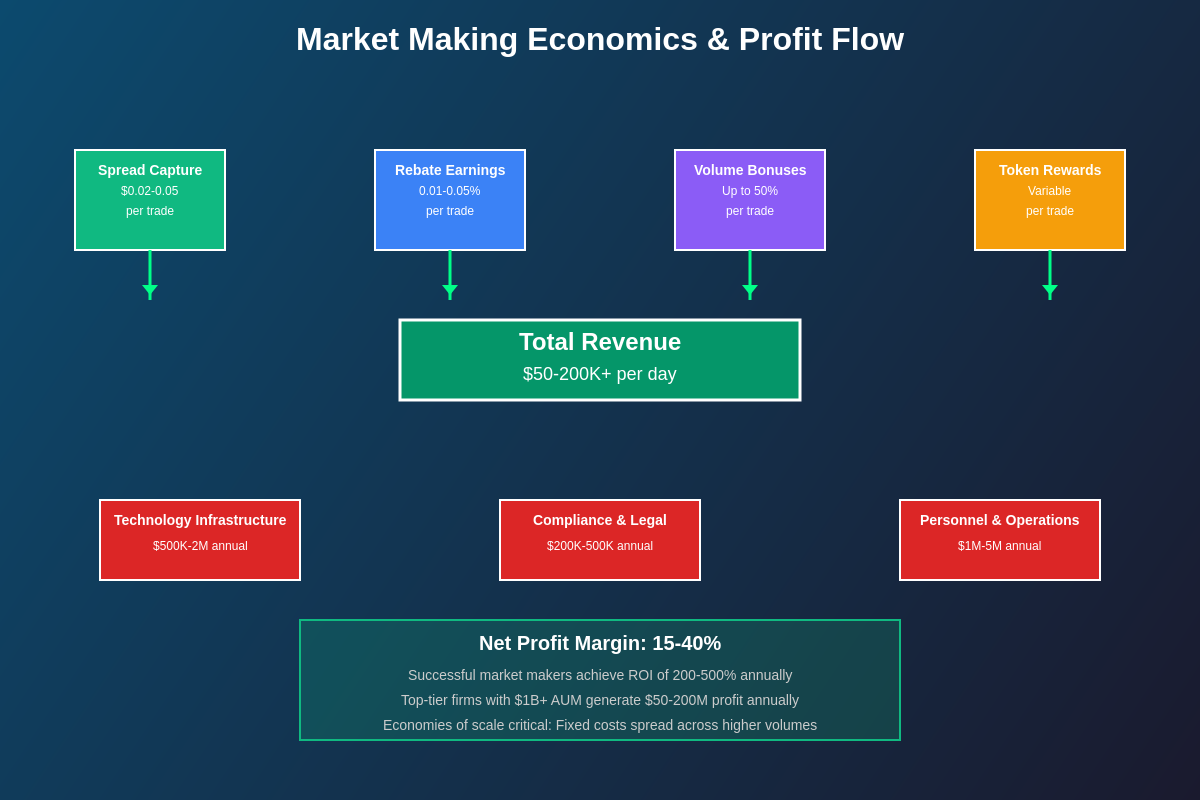TradingView Market Making Tools
Understanding Market Making Economics
Market making represents one of the most sophisticated and profitable trading strategies in cryptocurrency exchanges, where specialized traders provide continuous liquidity by simultaneously placing buy and sell orders around the current market price. The economic incentives that drive market making activities are fundamentally different from traditional trading approaches, with exchanges offering elaborate rebate programs designed to attract and retain professional market makers who ensure deep order books and tight bid-ask spreads.
The fundamental economics of market making revolve around capturing the spread between bid and ask prices while managing inventory risk through sophisticated hedging strategies and high-frequency position adjustments. Professional market makers earn profits not from directional price movements but from the steady accumulation of small spreads multiplied across thousands of trades per day, creating a business model that thrives on volume, volatility, and efficient execution infrastructure.
Market makers serve as essential intermediaries in cryptocurrency markets by providing immediate liquidity for traders who want to buy or sell assets without waiting for matching counterparties. This liquidity provision reduces price impact for large trades, narrows bid-ask spreads for all market participants, and creates more efficient price discovery mechanisms that benefit the entire trading ecosystem while generating substantial revenue for both market makers and exchanges through increased trading volumes.
Exchange Rebate Program Architecture
Cryptocurrency exchanges have developed increasingly sophisticated rebate programs to incentivize market making activities, recognizing that deep liquidity attracts institutional traders, reduces volatility during large transactions, and creates positive network effects that drive platform growth. These rebate programs typically operate on tiered structures where market makers receive progressively higher rebates based on their trading volumes, market share, and the quality of liquidity they provide to the platform.

Traditional rebate structures follow maker-taker models where market makers who add liquidity to order books receive rebates while traders who remove liquidity pay fees. Leading exchanges like Binance and Coinbase offer rebates ranging from 0.01% to 0.05% of trade value to qualifying market makers, with premium tiers providing additional benefits including reduced settlement times, priority customer support, and access to advanced trading APIs with higher rate limits.
The most competitive rebate programs extend beyond simple percentage rebates to include volume-based bonuses, token incentives paid in exchange native tokens, and performance-based rewards that recognize market makers who maintain tight spreads during volatile market conditions. These comprehensive incentive structures can result in effective negative trading costs for high-volume market makers, creating sustainable competitive advantages for firms that can achieve the scale and sophistication required to maximize rebate earnings.
Market Making Strategy Implementation
Professional market making requires sophisticated algorithmic trading systems capable of monitoring multiple order books simultaneously, managing inventory across different assets and exchanges, and executing thousands of order updates per second in response to market movements. The core strategy involves maintaining continuous two-sided markets with buy orders slightly below current market prices and sell orders slightly above, capturing the spread while managing the risk of adverse selection and inventory accumulation.
Risk management represents the most critical component of successful market making operations, with firms employing delta-neutral hedging strategies, position limits, and sophisticated inventory management algorithms to prevent catastrophic losses during extreme market movements. Market makers must balance the competing objectives of maximizing rebate earnings through high trading volumes while minimizing exposure to directional price risk through careful position management and rapid inventory turnover.
The technological infrastructure required for competitive market making includes co-located servers near exchange data centers, specialized trading software capable of microsecond-level order execution, and robust risk management systems that can halt trading operations automatically when predefined risk thresholds are exceeded. Leading market making firms invest millions of dollars in technology infrastructure to achieve the speed and reliability advantages necessary to compete effectively in high-frequency trading environments.
Regulatory Framework and Compliance Requirements
Market making activities operate within complex regulatory frameworks that vary significantly across jurisdictions, with different requirements for capital adequacy, risk disclosures, and operational transparency depending on the exchange location and target customer base. Professional market makers must navigate securities regulations, anti-money laundering requirements, and market manipulation rules while maintaining compliance with tax obligations across multiple jurisdictions where they operate trading infrastructure.
The regulatory landscape for cryptocurrency market making continues to evolve rapidly as traditional financial regulators adapt existing frameworks to address the unique characteristics of digital asset trading. Recent developments include proposals for enhanced disclosure requirements for market makers, restrictions on certain high-frequency trading practices, and increased scrutiny of the relationships between exchanges and their preferred market making partners to ensure fair access and competitive market conditions.
Compliance infrastructure for market making operations includes comprehensive trade surveillance systems, detailed record-keeping requirements, and regular reporting to relevant regulatory authorities about trading activities, risk exposures, and financial condition. The costs associated with regulatory compliance represent significant barriers to entry for smaller market making firms while creating competitive advantages for established players with robust compliance infrastructure and legal expertise.
Technology Infrastructure and Execution Systems
The technology stack powering modern market making operations represents some of the most sophisticated trading infrastructure in financial markets, with requirements for ultra-low latency execution, real-time risk monitoring, and seamless integration with multiple exchange APIs simultaneously. Core system components include order management systems capable of handling thousands of orders per second, portfolio management systems that track positions across multiple venues in real-time, and execution algorithms optimized for minimal market impact and maximum rebate capture.

Network infrastructure optimization plays a crucial role in market making competitiveness, with leading firms investing in direct market data feeds, co-location services at exchange data centers, and dedicated network connections to minimize the latency between market data reception and order execution. These infrastructure investments can reduce execution latency from milliseconds to microseconds, providing decisive advantages in fast-moving markets where the difference between profitable and unprofitable trades often depends on execution speed measured in fractions of a second.
Data management and analytics systems enable market makers to continuously optimize their strategies based on historical performance analysis, market microstructure patterns, and real-time profitability metrics. Advanced market making operations employ machine learning algorithms to predict short-term price movements, optimize spread sizes based on market conditions, and automatically adjust position limits based on volatility forecasts and risk exposure calculations.
Risk Management and Capital Requirements
Effective risk management in market making operations requires sophisticated understanding of various risk factors including inventory risk from holding positions in volatile assets, operational risk from technology failures or connectivity issues, and counterparty risk from exchange insolvency or frozen funds. Professional market makers employ multiple layers of risk controls including real-time position monitoring, automated stop-loss mechanisms, and diversification across multiple exchanges and asset classes to minimize exposure to any single source of risk.

Capital requirements for market making operations vary significantly based on the scale of operations, number of supported trading pairs, and target market share objectives. Successful market making firms typically maintain substantial capital reserves to support inventory positions, meet margin requirements across multiple exchanges, and provide sufficient buffer for unexpected losses during extreme market conditions. The capital efficiency of market making operations depends on sophisticated inventory management strategies that minimize the amount of capital required to maintain target market share while maximizing rebate earnings.
Stress testing and scenario analysis represent critical components of market making risk management, with firms regularly evaluating their exposure to various market scenarios including flash crashes, exchange outages, and extreme volatility events. These analyses inform position limits, hedging strategies, and capital allocation decisions while helping firms prepare for operational challenges that could threaten the viability of their market making activities.
Competitive Landscape and Market Structure
The cryptocurrency market making landscape has evolved from a fragmented ecosystem dominated by individual traders to a sophisticated industry controlled by well-capitalized institutional firms with advanced technology infrastructure and deep financial resources. Leading market making firms including Alameda Research, Jump Trading, and Wintermute have achieved dominant market positions through superior technology, strategic exchange partnerships, and substantial capital commitments that enable them to provide liquidity across hundreds of trading pairs simultaneously.
Competition among market makers has intensified significantly as the cryptocurrency market has matured, with firms competing on multiple dimensions including spread tightness, order book depth, uptime reliability, and ability to provide liquidity during stressed market conditions. This competition has generally benefited retail traders through improved market quality, but has also created barriers to entry for new market making firms that struggle to compete with established players who have achieved scale advantages and preferential exchange relationships.
Market structure evolution continues to favor institutional market makers through the development of more sophisticated trading venues, advanced order types designed for professional liquidity providers, and regulatory frameworks that provide clearer guidelines for institutional participation in cryptocurrency markets. These developments suggest continued consolidation in the market making industry as smaller firms struggle to compete with the technology investments and regulatory compliance costs required for sustainable operations.
Economic Impact on Trading Ecosystems
Market making activities generate substantial economic benefits for cryptocurrency trading ecosystems by reducing transaction costs for all market participants, improving price discovery efficiency, and creating more stable market conditions during periods of high volatility. The presence of active market makers typically results in spreads that are 50-80% tighter than markets without professional liquidity providers, directly reducing trading costs for retail and institutional traders while improving overall market quality.
The volume multiplier effects of effective market making can dramatically increase exchange trading volumes and revenue, with studies suggesting that professional market making programs can increase trading activity by 200-400% compared to markets without dedicated liquidity providers. These volume increases benefit exchanges through higher fee revenue while creating positive network effects that attract additional traders and further improve market liquidity in a virtuous cycle of growth and development.
Economic research on market making impacts suggests that the social benefits of improved market quality generally outweigh the costs of rebate programs, with the efficiency gains from reduced spreads and improved liquidity providing net positive benefits to the broader trading ecosystem. However, concerns about market concentration and the potential for market manipulation by dominant market makers continue to drive regulatory scrutiny and proposals for enhanced oversight of market making activities.
Technological Evolution and Future Trends
The future of cryptocurrency market making is being shaped by several technological trends including the development of decentralized exchanges with automated market makers, cross-chain liquidity protocols that enable market making across multiple blockchain networks, and artificial intelligence systems that can optimize market making strategies in real-time based on market conditions and competitive dynamics.
Decentralized finance protocols are creating new opportunities for market making through liquidity mining programs, automated market maker pools, and cross-chain arbitrage opportunities that traditional centralized market makers are beginning to explore. These DeFi developments require different technical approaches and risk management strategies while offering the potential for new revenue streams and competitive advantages for firms that can effectively navigate the decentralized trading landscape.
Machine learning and artificial intelligence applications in market making continue to evolve rapidly, with firms developing more sophisticated prediction models, optimization algorithms, and automated strategy adjustment systems that can respond to changing market conditions without human intervention. These technological advances promise to further increase the efficiency and profitability of market making operations while potentially reducing the barriers to entry for firms with strong technical capabilities but limited capital resources.
Global Regulatory Harmonization Trends
International regulatory coordination efforts are beginning to address the cross-border nature of cryptocurrency market making, with regulators recognizing the need for consistent frameworks that prevent regulatory arbitrage while ensuring effective oversight of systemic risks. The Financial Stability Board and other international organizations are developing guidelines for cryptocurrency market infrastructure that will likely impact market making regulations across multiple jurisdictions.
Regulatory trends toward increased transparency requirements for market makers include proposals for real-time reporting of positions and trading activities, enhanced disclosure of exchange relationships and fee arrangements, and standardized risk reporting frameworks that will provide regulators with better visibility into market making operations and their potential systemic impacts.
The evolution of regulatory frameworks toward functional regulation rather than entity-based regulation suggests that market making activities may face similar oversight requirements regardless of whether they are conducted by traditional financial institutions or cryptocurrency-native firms. This convergence could create opportunities for traditional market makers to enter cryptocurrency markets while requiring cryptocurrency market makers to adopt more sophisticated compliance and risk management practices.
Economic Incentive Optimization Strategies
Advanced market making firms are developing increasingly sophisticated approaches to optimize their economic incentives across multiple exchanges and trading venues, employing complex algorithms that allocate trading activity to maximize rebate earnings while maintaining competitive market positions. These optimization strategies consider factors including relative rebate rates, volume thresholds for tier advancement, and the competitive dynamics specific to different trading pairs and market conditions.

Portfolio-level optimization of market making activities involves coordinating strategies across multiple assets to achieve optimal risk-adjusted returns while maximizing rebate earnings and maintaining desired market share targets. This holistic approach requires sophisticated risk management systems and optimization algorithms that can balance competing objectives while adapting to changing market conditions and competitive pressures.
The development of cross-venue arbitrage strategies that exploit rebate differentials between exchanges represents an advanced form of market making that can generate additional revenue streams while providing valuable price discovery services across fragmented cryptocurrency markets. These strategies require substantial technological investments and sophisticated risk management capabilities but can provide sustainable competitive advantages for firms with the resources to implement them effectively.
Conclusion and Industry Outlook
The cryptocurrency market making industry continues to evolve rapidly as exchanges compete for liquidity, technology advances enable new trading strategies, and regulatory frameworks mature to address the unique characteristics of digital asset markets. The economic incentives that drive market making activities will likely become even more sophisticated as exchanges develop new rebate structures, cross-chain opportunities emerge, and competitive pressures continue to drive innovation in trading technology and strategy development.
Professional market making firms that can successfully navigate this evolving landscape while maintaining effective risk management and regulatory compliance will continue to benefit from substantial economic opportunities in the growing cryptocurrency market. The barriers to entry continue to increase as technology requirements become more sophisticated and regulatory compliance costs rise, suggesting continued consolidation around well-capitalized firms with advanced technical capabilities.
The long-term outlook for cryptocurrency market making remains positive as institutional adoption increases, market infrastructure continues to mature, and new opportunities emerge in decentralized finance and cross-chain trading protocols. However, success in this competitive environment will require continued investment in technology, risk management, and regulatory compliance as the industry evolves toward greater sophistication and oversight.
Professional Trading Strategies
Disclaimer: This article is for educational and informational purposes only and should not be construed as financial advice. Cryptocurrency trading involves substantial risk of loss and is not suitable for all investors. Market making strategies require sophisticated risk management and substantial capital, and past performance does not guarantee future results. Always conduct your own research and consult with qualified financial advisors before making investment decisions. Trading cryptocurrencies can result in significant financial losses, and you should never invest more than you can afford to lose.